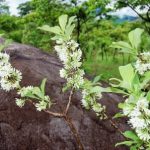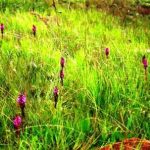TREE LIFE
June 2005
MASHONALAND CALENDAR
Saturday 4th June. Botanic Garden Walk. Subject ‘Rare Trees.’ Meet Tom in the car park at 10.45 for 11 a.m.
Sunday 19th June. An all day visit to Kutsaga Tobacco Research Station. This is a new venue for us so it will be interesting. Bring your lunch and a chair for an all day outing.
Friday 24th June and Saturday 25th June. The Aloe, Cactus and Succulent Society are holding an Aloe Show at the Botanic Gardens, Fifth Street. On Saturday there will also be a plant sale.
Light refreshments will be available at the restaurant in the gardens.
Saturday 25th June. Mark’s walk this month is cancelled
Sunday June 26th. Various activities are planned at the Mukuvisi Woodlands to celebrate the 25th anniversary of its founding. As part of the program Meg Coates Palgrave will lead a walk in the morning and one in the afternoon. The morning walk starts at 9 a.m. and will last about an hour. The afternoon walk also taking about an hour starts at 3 p.m.
MATABELELAND CALENDAR.
Please contact Jean Wiley or Gill Short for details of the next Matabeleland function.
Subs are now overdue and this is just to refresh our memories.
SUBSCRIPTIONS FOR 2005-6
The Tree Society’s subscription year is from 1 April 2005 to 31 March 2006 and once again it is my unpleasant duty to write to members advising them of the subscriptions for next year.
As you will recall, the Society used to produce a hard copy of Tree Life every month and post it out to all the members. However, rising postal costs and also paper and duplication costs forced us to review that approach and we have switched to sending out Tree Life as an email attachment.
The take-up has been good and the majority of members now receive Tree Life by email.
However, there has remained a proportion of the members who do not have email. Last year a 2-tier approach was introduced, with a higher charge for those receiving Tree Life by post.
However, during the year we have seen an extraordinary rise in the cost of postage to its current $6,900.
This rise, well above the official rate of inflation, has led the Committee once again to review the system we use for sending out Tree Life.
For 2005-6, there will be a three tier system.
- Those receiving Tree Life by email will pay $30,000.
- Those who wish to receive a hard copy of Tree Life and are willing to collect it (or in some cases delivery can be arranged) will pay $60,000.
- Those who wish to receive a hard copy of Tree Life by post will pay $150,000.
In effect we have removed the subsidy of those receiving by email and I imagine that at that price, postal deliveries will be strongly discouraged.
The Committee has always been worried that those members without email might be our poorest members who were least able to pay the higher amounts. I must emphasise that arrangements exist for the support of members (some members pay more than the required rates for this purpose). We would hate to lose people because of rising costs. Please talk to either me, Terry Fallon or Maureen Silva-Jones. All such requests will be treated confidentially.
If you are paying your subs by cheque, please make it payable to: (NB This bit has changed.)
CABS
And on the back of the cheque
“Tree Society Account”
Mark Hyde, Chairman
BOTANIC GARDEN WALK: 1 MARCH 2005
The subject of today’s walk was the trees that grow on termite mounds. Tom explained that the soils on termite mounds have a higher pH (i.e. more alkaline) than the surrounding vegetation and that furthermore, the termites bring in nutriments, thereby creating a more fertile environment.
As we so often see on our walks, termite mounds are islands of vegetation which (a) bear completely different species to the surrounding woodland or grassland and (b) are much richer in species. Often, very large numbers of species can be found crowded on a single mound.
The consequence of this species richness is that there are a huge number of species involved, many of which were seen on our walk. The following is a selection of those seen, with a few notes about each species.
-
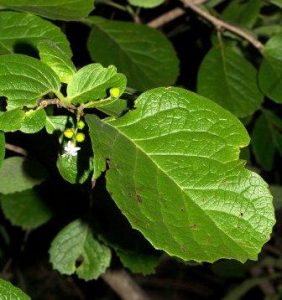
Ehretia obtusifolia. Photo: Bart Wursten. Source: Flora of Zimbabwe
Carissa edulis – an attractive ornamental species. Tom remarked that this has fruit “which you don’t need to be hungry to be enjoy”;
- Maytenus heterophylla – another common species, very characteristic of termite mounds;
- Ziziphus mucronata (Buffalo thorn) – very often on termite mounds;
- Cassia abbreviata – rough bark and attractive pale yellow flowers;
- Ehretia obtusifolia – in the shady understorey of termite mounds and has exceptionally rough leaves;
- Cassine transvaalensis – typically a mound species;
- Boscia salicifolia – frequent on mounds, as are many Capparaceae.
- Pterocarpus rotundifolius subsp. rotundifolius (the Round-leaved bloodwood) – occurs on termite mounds in Harare south. This is a common and, during its flowering period, a beautiful and showy tree;
- Flueggea virosa (the Snow berry) – a common species, very characteristic of mounds. It has fresh green leaves and white berries.
- Berchemia discolor (Brown ivory) is abundant on termitaria in the SE lowveld. This has characteristic shiny leaves with parallel lateral veins. The fruit is ellipsoid.
- Tamarindus indica (the Tamarind) is another low altitude species of termitaria. Some think it is introduced but in Tom’s opinion it is a native species.
- Triplochiton zambesiacus is another species, occurring at low altitudes – e.g. in Gokwe North. It is a tree with palmately lobed leaves like a maple.
A common distribution is of plants which are riverine at low altitudes but occur on termitaria at medium and high altitudes.
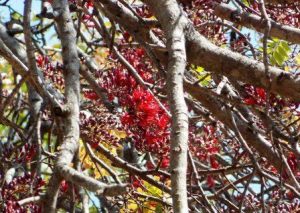
Schotia brachypetala. Photo: Penny English. Source: Flora of Zimbabwe
One example of this is Schotia brachypetala (the Fuchsia tree), which is absolutely characteristic of (and confined to) termitaria at the altitude of Harare but is also a large tree in riverine vegetation in the SE lowveld (for example by the Shashi River at the Wildlife Society accommodation near the Tuli Circle).
In addition, one Acacia has the same distribution, namely Acacia galpinii. This may be seen on mounds by the main road past Lake Chivero.
A third taxon of this type is Diospyros mespiliformis. The ripe fruits of this species are very attractive. Tom mentioned that he has seen as many as 100 monkeys in a tree when the fruit is ripe.
All in all, a very interesting walk and our great thanks go to Tom for leading us.
-Mark Hyde
If you venture into Mozambique, down near Inhambane, consider visiting a noble lady of the Morrungulo bush, a truly magnificent musasa. Escaping the general meltdown into charcoal, this giant Brachystegia spiciformis reclines regally in the now defunct grounds of the Mangonya Mission. The impressive facade of the church looks out over hospital, school, living quarters and admin. buildings of a bygone age, and following the semi-circular sweep of a line of red mahoganys, you come upon a small well-kept meeting hall, beautifully constructed of coconut fronds and thin poles, and above it the spectacular mass of the musasa canopy. She leans away from wearying Indian Ocean winds and supports two equally large branches clothed in a 34 meter umbrella of leaves and pockets of orchids. We measured the circumference of the huge bole one meter up and photographed her from all sides. In Lyn Mullin’s book, Historic Trees of Zimbabwe, the great tree of Oribi Farm near Harare stands 29 meters and measures 1,41 m across the bole. The mission musasa is shorter at about 18 m (reclining) and yet is larger in girth at an impressive 1,64 m. The densely leafed canopy is two meters broader than her Zimbabwe sister. James Nelson, our guide, showed us the other lovely mature trees on a nearby farm, and then took us back to the Morrungulo Dive Centre to see if we could identify a glade of attractive leafy-green trees in his camp.
He explained that the 9 m trees had never flowered and that, moreover, the local Mozambicans had no idea what they may be. The bark was reddish-brown, wrinkled under the join of each branch. There were scar-like markings, multi-shaped areas on the main trunks, although the bark generally was smooth to look at. The leaves had one to three pairs of pinnae, each with three or four pairs of large leaflets, the final two being markedly larger. They appeared to be Albizia glaberrima (no.178), the lowveld albizia (later confirmed by the Nat. Herbarium). This Albizia is not on record either on the coast or in this area so it remains a mystery as to how this shady little glade got here. If anyone else is in the area and wish to visit the mission musasa it is best to contact James Nelson of Morrungulo.
-J. Wienand
BOTANIC GARDEN WALK 5th April 2005
Tom Muller led a party of eight on a brisk walk on a damp Tuesday evening around the Botanic Gardens, looking for members of the family Celastraceae. The few walkers who carried umbrellas made sure the rain kept away. The Celastraceae is also known as the Spike-thorn family and contains mainly shrubs and small trees, some of which have thorns. The family is not well represented in Zimbabwe, but there are a few members that are common around Harare.
Meg Coates-Palgrave, in the latest edition of her book, says “The generic relationship within this family is still in flux”. Members of the Tree Society are still coming to terms with the removal of the thorny members that used to belong to the genus Maytenus to the genus Gymnosporia. However, taxonomic puzzles within these two genera do not end there. Tom showed us two examples of plants that had belonged to the Maytenus heterophylla complex and were now officially both Gymnosporia buxifolia. One was the blue-green spiny shrub that we often see growing on termitaria near Harare. The other had much shinier green leaves and grows on the edges of rain forests; Tom mentioned that it often smells “like the toilet on a building site”, and he had had to dig it out of a garden that he was landscaping because the owner could not stand it. It is difficult to accept that these very different plants belong to the same species.
To emphasize the problems of taxonomy in the family, a small party of us had been looking that morning for the large Wild Olives (Olea europea) that Lyn Mullin reported were growing along the Manongo river in Glen Lorne. We failed to find them, but I did find a small tree with fruit that I did not recognise, so brought it for the experts to see. There was a consensus that it belonged to the Maytenus heterophylla complex, probably a Gymnosporia, possibly G. maranguensis. I sat down with Meg’s book and was unable to reach an identification that convinced me; the tree showed points of identity and of difference with three species, G. maranguensis, G. senegalensis and Maytenus undata.
But back to Tom’s walk. We first looked at the genus Hippocratea, which contains shrubs, climbers or small trees that have characteristic stiff, paired branchlets growing at right angles to the main stem that help them to climb; sometimes these branchlets curl at the end, like tendrils. The three species we found were H. parvifolia, a constituent of jesse bush and lowveld river fringes; H. africana, which prefers river fringes and rain forest, notably at Victoria Falls and the Vumba; and H. buchananii, which is found in jesse and, according to Tom, rain forest as well. The fruit are distinctive “paddle-pods”, with three separate mericarps joined at the base, each of which splits into two valves to release winged seeds.
Growing in close association with the H. africana, and causing us some confusion, we found our first specimen of Eleaodendron (formerly Cassine) schlecterianum, a small erect lowveld tree which is easily spotted on the road to Mana Pools in the dry season as it provides one of the few splashes of green in the jesse; we found more specimens growing by themselves further on.
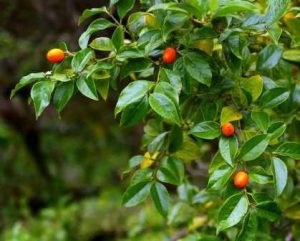
Cassinopsis ilicifolia. Photo: Meg Coates Palgrave. Source: Flora of Zimbabwe
In the genus Gymnosporia, apart from the G. buxifolia that I have already mentioned, we found a G. harveyana (formerly part of the Maytenus mossambicensis complex) growing in the rain forest. It was a small, spiny, shiny-leaved tree that by good fortune was bearing flowers and fruit. The flowers were small, delicate, white five-petalled stars growing on long stalks; the fruit were small, round, yellow/pink, that dehisced into three lobes.
The last two plants we found on our walk were Cassinopsis ilicifolia, a spiny shrub with yellow/orange fruit that grows in the Eastern Districts forests, and Mystroxylon aethiopicum (formerly Cassine or Elaeodendron; how confusing can it get?), a very widely-distributed species with four subspecies, that grows on termite mounds and in rain forest in Zimbabwe and has characteristic shiny leaves with conspicuous yellow veins.
Darkness overtook us before we had seen all the family members that Tom had in store for us. The remainder will be dealt with in May.
-John Lawrence
MARINGAMBIZI, MTOROSHANGA: 17 APRIL 2005
Today saw a return visit to Maringambizi by kind permission, once again, of Barbara Scheidler. Our last visit was in the hot, dry month of October; this time we hoped to see more trees in leaf and perhaps some interesting herbaceous vegetation.
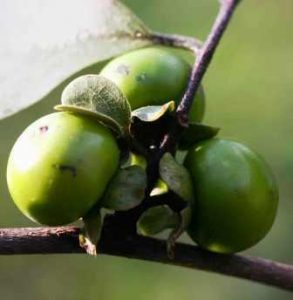
Diospyros squarrosa. Photo: Mark Hyde. Source: Flora of Zimbabwe
After some initial difficulties in finding the place (the sign had been taken down and we all drove merrily past the turning), we all eventually assembled at the house. Close by, amongst some rocks, was a quite unusual species, Diospyros squarrosa, in green fruit with 4 prominent reflexed sepals. This is a tree of medium and low altitudes occurring along the main river valleys (per FZ) up to an altitude of 1200 m – actually slightly higher here.
We then set off towards the campsite amongst some rocky hills, an interesting place where we have walked before. Even this part of the journey was not without hitch, as I hesitated on the way leading to some delay, but eventually we realized that we were correct after all.
Before discussing the trees it is worth noting that the altitude was quite a bit lower than Harare at 1270 m. As always, altitude is a critical factor in understanding the vegetation.
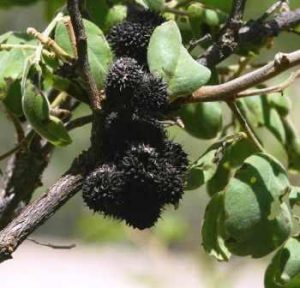
Dalbergia nitidula. Photo: Bart Wursten. Source: Flora of Zimbabwe
The first bit of woodland, before we reached the rocks and their associated flora, appeared to consist largely of Julbernardia globiflora (the mnondo) and later Barbara confirmed that there is very little msasa on Maringambizi. On the Julbernardia was the parasitic plant, Berlinianche aethiopica. This was formerly known as Pilostyles aethiopica. In our experience, the mnondo is its commonest host. Also in the woodland was Dalbergia nitidula (Glossy flat-bean). This small tree, which may be semi-climbing, had a noticeably dark, rough bark. Leaves are 1-pinnate with alternate leaflets. It is a species of woodland often in rocky places.
Also in the woodland was Pericopsis angolensis, (Muwanga) a species of slightly lower altitudes than Harare and hence to be expected in a place such as this. The tree is somewhat similar to a Dalbergia with its flattened pods and 1-pinnate leaves. The leaflets, again like Dalbergia (and related species such as Xeroderris) are alternate or sub-opposite. As is typical, the bark is a noticeably pale whitish-grey and there was the inevitable “dead branch on the left hand side”!
On to the rocky slopes and immediately we were, botanically speaking, in a completely different world. Here was Pouzolzia mixta, (Soap nettle), a small, soft deciduous shrub or tree from the Urticaceae, with leaves that are green above and white beneath. Unlike many Urticaceae, this species is not a stinging species. Already, even by mid-April, the leaves had mostly fallen off.
Combretum apiculatum is a common species generally at lower altitudes. Its leaves are usually recognisable by their glossy, slightly brownish appearance as if varnished and the asymmetrical leaf apex.
Also present was Commiphora marlothii, the Paperbark commiphora, with its striking green peeling bark. Two other species also possessed striking bark: namely Albizia tanganyicensis (Paperbark albizia) and Sterculia quinqueloba (Large-leaved star-chestnut).
The latter two were growing side by side. Both were in fruit and it was possible to make an easy comparison of the two. Leaves, flowers and fruit are all completely different – it is just the bark which is somewhat similar.
Two trees with striking autumnal colours were Kirkia acuminata, the leaves of which were turning strongly yellow, and Hymenodictyon floribundum, the fire bush with its already red leaves. Trees of these species were very noticeable on the surrounding rocky hills.
After this we left the rocky area and headed down a track though further woodland, eventually arriving at an embankment overlooking the dam. The walk through the woodland was not particularly exciting but some new species came to light. One was Uapaca nitida (the narrow-leaved mahobohobo) which is locally common to the north of Harare.
Another species, from the Annonaceae was Hexalobus monopetalus. Again, this is a fairly common species seen quite frequently on our outings with the usual Annonaceae combination of aromatic leaves and no stipules.
As we headed back towards the car park, we chose a short cut and, temporarily, got lost. Fortunately, John Lawrence managed to find a way back and we discovered that we were actually quite close to the cars.
Then, back to the house for an al fresco lunch. In the afternoon, energy levels were a bit low, so we only did a short walk around the house, where we saw an interesting combination of wild and planted species.
Once again, our thanks go to Barbara for allowing us to visit. We hope to go back some time in the future.
-Mark Hyde
THE PETHERAM FILES Continued…..
File 6 The Capital City
This file, labelled Salisbury, contained mainly press cuttings from The Herald and The Sunday Mail about notable trees in Harare. What follows has been compiled from these cuttings and from Dick Petheram’s rough notes.
The First Jacarandas
The Hon. Joseph M Orpen, MP in the Cape Parliament and South African High Commissioner in Basutoland, was persuaded by Rhodes to come to Rhodesia and into the first Executive Council of the new Colony, along with William Henry Milton, Joseph Vincent, Thomas Charles Scanlen, etc. Orpen later became Surveyor-General.
One of Rhodes’s confidential clerks, Arthur Holland, was sent up at this time to join Milton’s staff in the then Salisbury. He married Orpen’s daughter, Madeleine. While in Durban, en route to take up his new position, Holland bought three jacaranda seedlings at the Botanic Garden, but only two of these arrived alive. One he gave to his prospective in-laws, the Orpens, who planted it at their home at No 23 Montagu Avenue (formerly Cape Avenue), and the other Holland planted at his own home at the corner of Salisbury Street (now Harare Street) and Montagu Avenue (now Josiah Chinamano Avenue). The actual planting date is not known with any certainty—it could have been 1898, 1899, or 1900—but, when the Orpen’s tree was finally identified and marked for posterity, the date on the plaque placed at the foot of the tree was given as 1900.
No 23 Montagu Avenue was acquired in the 1980s for the development of Town Houses, appropriately named “Jacaranda Mews”, and the developers took good care to preserve the historic tree. Sadly, it simply collapsed in about 1998, and a year or two later the stump became covered by a huge bracket fungus, possibly a species of Ganoderma, that reached a diameter at its widest of 1.3 metres.
The jacaranda that was planted by Arthur Holland at the corner of Josiah Chinamano Avenue and Harare Street fell to the axe in 1976 to make way for a petrol service station that was being developed on the site. Arthur Holland’s grandson, André Holland, a Member of Parliament, used to visit the tree regularly, and was aghast when he found it gone. There was no commemorative plaque, and the developers did not know of its historical associations.
Arthur Holland also imported flamboyants (Delonix regia) and frangipani trees (Plumeria rubra), and planted them in Harare (Encyclopaedia Rhodesia, page 191 under Jacaranda), but there is no indication of dates or locations within the city.
There were other jacarandas that were put forward as “the first”, notably one at 140 Fern Road in Hatfield, but it lacked the authentication of the two brought into the country by Arthur Holland.
Another contender for the title of “first jacaranda” was planted at the site of the first double-storey building in Harare, a pre-fabricated, wire-wove house erected for the Senior Judge at Greenwood, later the site of the New Manor Hotel, on what is now the corner of Samora Machel Avenue and Fifth Street (see GH Tanser, 1965, A Scantling of Time, page 134). In July 1900, a Mrs Lewis, who had transferred from the Kopje to the double-storey house, wrote of the garden, in which there was a “marvellous jacaranda which is full of lovely blue flowers” (Scantling of Time, page 226), which suggests that this tree might have been older than those planted by the Orpens and the Hollands, but it has long-since disappeared from the scene.
-Lyn Mullin To be continued
HISTORIC TREES OF ZIMBABWE By LYN MULLIN.
Copies of this wonderful book are still available from Maureen Silva-Jones.
Telephone. Home 740479; Work 757171 (Harare)
Unavoidably prices have increased to:
Soft Cover – $150 000.00
Hard Cover – $225 000.00
Leather Bound – $300 000.00
MARK HYDE CHAIRMAN


